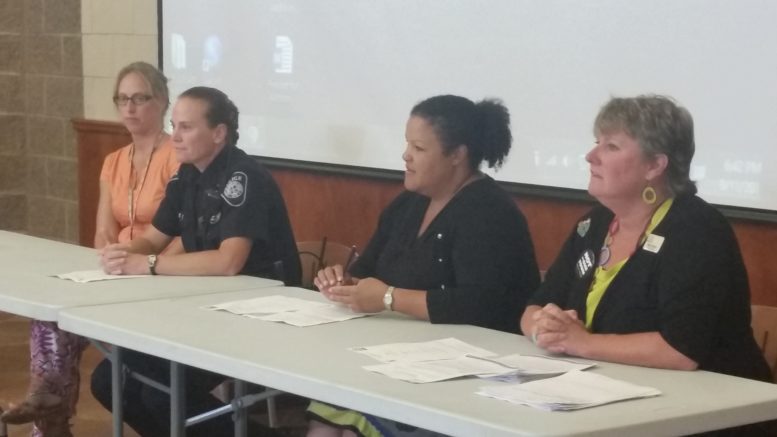By JAN LARSON McLAUGHLIN
BG Independent News
The Bowling Green mom asked for help not crossing the line between protecting her two children from “bad guys” and making them fearful of the world.
“I want them to be cautious, but not paranoid,” she said, Thursday evening during a meeting to help parents talk with their children about troubled times and the violence erupting around the world. The meeting was hosted by the Bowling Green School District and Not In Our Town.
“They are overwhelmed,” Rev Gary Saunders, of Not In Our Town, said of many parents wondering how to explain mass shootings and terrorism to their children. “They can’t believe that it’s happening. Yet they have the task of making meaning of this.”
A panel of experts who work with children advised that parents talk with their children, and listen to what they have to say.
“Children are so very perceptive and they pick up more than we adults realize,” said Ana Brown, coordinator for Diversity Initiatives at Bowling Green State University.
“They are going to make meaning of things themselves if you’re not there with them,” said Christina Lunceford, assistant professor of higher education and student affairs at BGSU.
Parents were told not to wait until they think their children are old enough to understand the violence. Much of today’s tragedies are not understandable at any age. But even preschoolers are soaking up bits and pieces of what they hear.
“The conversations should happen at a very young age and they should be continuous,” Lunceford said. “You can’t not do it because it’s hard and uncomfortable.”
In the not so distant past, parents felt they had done their duty to teach their children not to take candy from a stranger or get in a vehicle with someone they don’t know. That just doesn’t seem like enough anymore. The list of dangers seems so much longer now.
“It’s really tough these days,” said Maria Simon, director of youth services at Wood County District Public Library. “This is their world. This is their future. They need to be aware of some of the things happening, but not to be scared of it.”
Mindy Bahnsen, of Children’s Resource Center, advised that parents listen to their children to find out how their minds are processing news of the violence.
“Keeping the conversation open is the main thing,” she said. “We have no idea what their little brain is thinking.”
A good starting point can be found in books, according to Simon. “I think a book is a great tool to start opening up and talking to your kids,” she said.
However, Simon explained that while there are many children’s books dealing with the difficult topics of divorce, diversity and death, there aren’t many addressing mass shootings or terrorism.
“These books about how to talk about violence with kids haven’t been written very much,” Simon said.
Simon also suggested drawing, singing or creating art of some kind could be good outlets for kids struggling with the violence. She also advised that parents not allow “screens” in children’s bedrooms and keep an eye on what they are viewing. A parent in the audience mentioned that some Pixar movies do a good job of helping kids and parents talk about complicated issues.
If viewing violence on the news with children, parents should make sure they process their feelings first, so their reactions don’t frighten their children even more, Bahnsen advised.
Robyn Short, of Bowling Green Police Department, works in the schools with all ages.
“These kids always amaze me with what they know,” she said. Recently during a Safety Town class, a 5-year-old talked to Short about the shootings in Orlando. Short reacted by trying to put the attack in perspective for the child. “There are tons and tons of good people in the world, and a few bad,” she said.
When asked about safety tips parents should share with children – with so much violence in today’s world – Short had some simple advice. Small children should be told that adults should never approach children when they are by themselves.
“Any adult who talks to you without talking to mom and dad is breaking the rules,” Short said.
And no “secrets,” she added. It was suggested that to avoid confusion for kids, that families use the word “surprise” when talking about good secrets like a surprise party.
The panel also touched on the “toxicity” of this presidential campaign, and how that may pose some challenges for parents.
One parent in the audience brought up concerns about people saying students are “just kids” when youth show intolerance for people different than them. “I worry that we are building another Dylan Roof,” she said referring to the young white shooter who killed nine black people worshipping in a church in Charleston, S.C.
Another mom talked about the difficulty explaining “white privilege” to her adult children, who are white.
Talking about these issues is the first step, Brown said.
“You cannot change the culture without starting the conversation,” she said.
Dr. Ann McCarty, executive director of teaching and learning at Bowling Green City Schools, said the district is working on equity issues and setting up a team to have “courageous conversations.” Teachers will be educated first about how some groups of children are being unintentionally marginalized.
When asked if the district will declare an “equity day,” McCarty said setting aside one day is insulting and the district will not do a “drive-by equity piece.”
“It’s got to be part of the culture and climate in your building,” she said.

